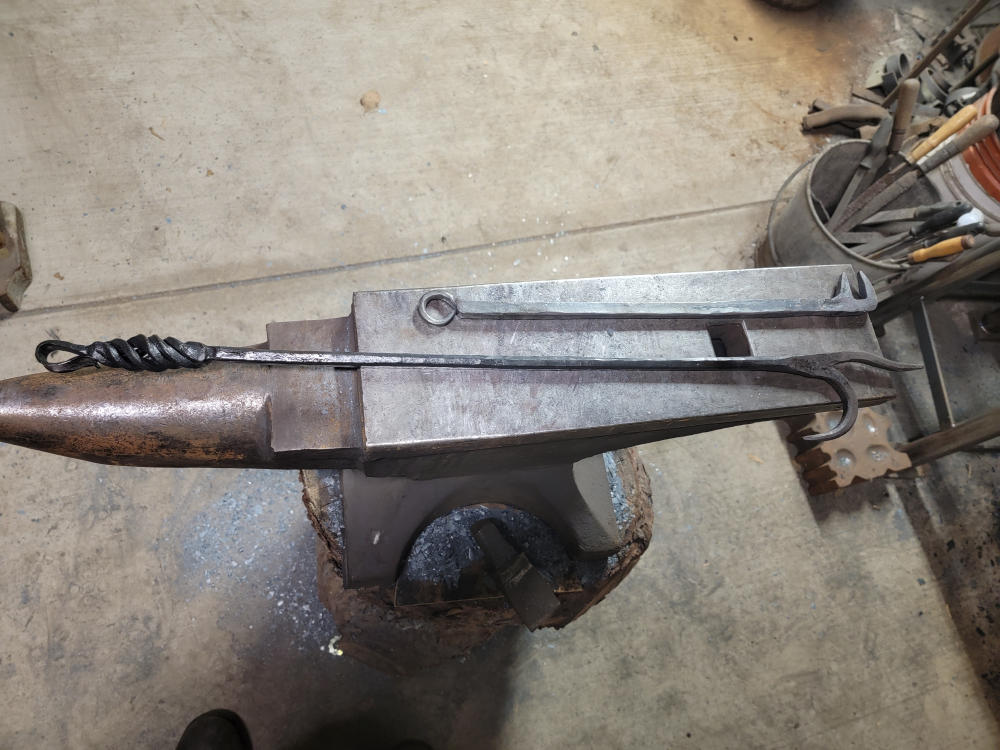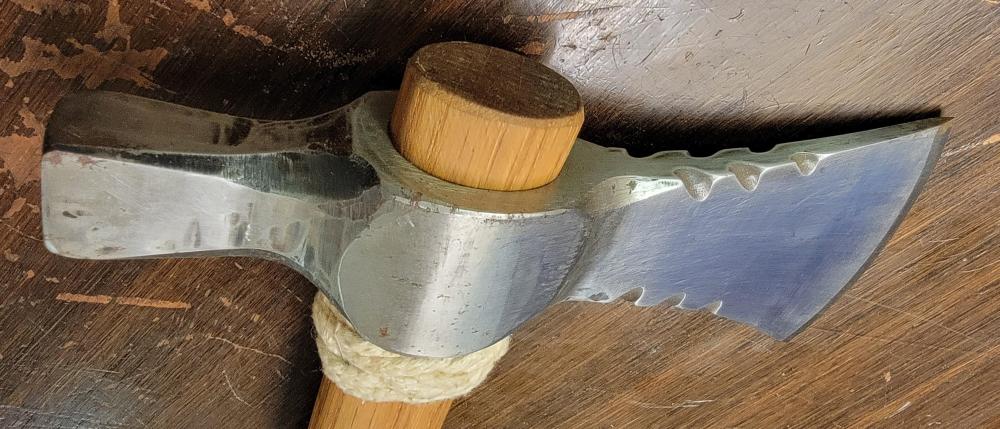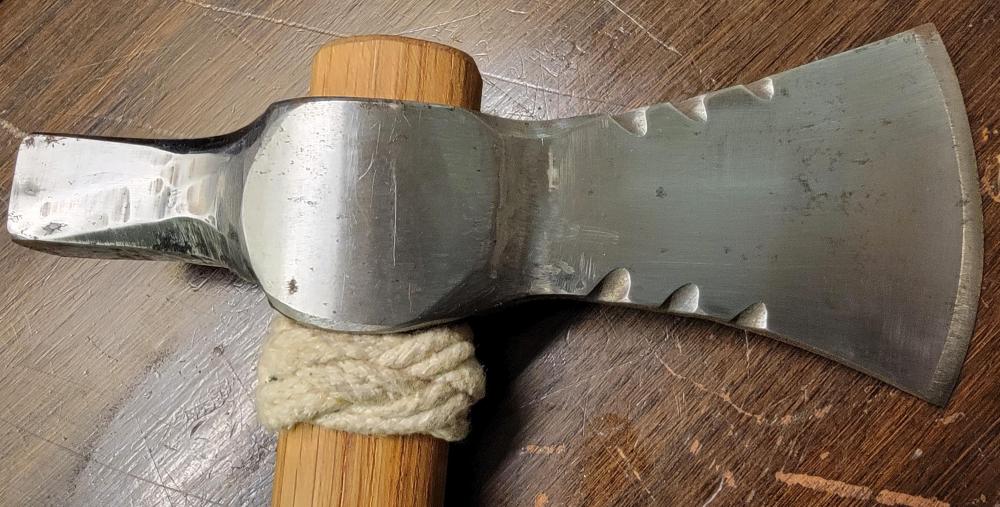-
Posts
2,169 -
Joined
-
Last visited
Content Type
Profiles
Forums
Articles
Gallery
Downloads
Events
Everything posted by Latticino
-
You have a very distinct style, which I admire greatly.
-
Manufacturer support is really the key for getting one of these. You will inevitably have to deal with repairs and maintenance at some point, and good support is key. That is certainly one issue with going with an older mechanical, you really need to have the chops to keep it working. The other issue is utility supply and support structure. For hammers the size you are looking at you will need a dedicated poured pad and 3 phase power. Hopefully you have that figured into your cost.
-
Swage size for consolidating elevator cable into a billet by forge welding wholly depends on the diameter of the cable itself. I have used either half round or 45 degree angled bottom swages for this, both work. You just need to have enough cable sticking up to hit while forge welding and enough width at the top opening not to pinch your cable diameter. You don't even need a swage, but it certainly makes it easier since you are compressing the cable radially (for a half round) or at least in two directions for a V-swage. Personally I think the half round works better, and has more general uses as well for other projects. I believe that JPH has posted one of her excellent videos on how to forge a half round swage that fits in a hardy hole.
-
Other issues: It is very difficult to accurately control the temperature at the edge of the blade if you are torch-tempering the spine with the blade in air (directly after quenching with no oven temper). You do want it to be tempered to remove some brittleness, but you don't want it to go full soft either. Some folks use the temper colors to determine what temperature the blade edge gets to, but these oxidizing colors can be deceiving (especially if there are any oil deposits on the blade). It can certainly work as a technique, but is more an art than science IMHO. Much easier to do with less critical, thicker, tools like chisels. If you torch temper with the blade in water the edge will never get up to correct temperature to properly temper it. If the blade was properly hardened it will remain brittle. I was taught that "blue-blacking" the spine to make the overall blade more resilient is best done after at least one round of normal oven tempering (almost always done off-screen on shows like Forge in Fire as it is too boring for the audience). You want any remaining austenite to fully convert to avoid later stress (two temper cycles are better for this). If you plan on blue-blacking the spine you can likely do a snap temper at a relatively lower temperature to maintain more hardness on the edge, but that still depends on the eventual use planned for the blade. A wet sand barrier works well for protecting that edge while torching
-
Hydraulic presses are arguably one of the most dangerous and expensive pieces of equipment that a smith can introduce into a shop. Until you have a lot more experience I strongly recommend that you avoid getting one. Only a very small percentage of smiths have even used a hydraulic press, much less owned one (regardless of what you see on FIF). Also, if you are completely new there are a bunch of other techniques that need to be mastered before you look at cannister, mosaic or other pattern welding. As George N.M mentioned, most of these can also be done without heavy equipment (albeit more slowly and less efficiently).
- 7 replies
-
- bladesmith
- knife
-
(and 7 more)
Tagged with:
-
During active forging you should have an opening in the top of your coal pile (or side if you are going for the "beehive" configuration) that will allow the coal gasses to burn off and prevent collection (use your poker and vent till you see some flame shooting out when cranking). This can be a particular problem if dumping wet coal with a lot of fines on top of your working fire. Add new coal to the perimeter of your existing pile and gradually introduce it to the mix as it dries out and starts to coke up. Vent as required. If you are banking your fire while taking a break, opening the ash dump should keep enough air flowing through your loosely packed coal pile to avoid this buildup.
-

Propane forge liner cracking…..need advice
Latticino replied to Jmmass3264's topic in Insulation and Refractories
I've never had much success with ceramic board roofs. In my experience they always seem to sag and crack. This is one of the main reasons I prefer a cylindrical forge body. On heat treat ovens I have used special SS board hanger pins to support this, but the forge temperatures will kill those. The wall cracks aren't a big deal, but the roof cracks are a structural issue. I suppose you could cast an arch inside your forge (Kastolite 30), but you would be giving up some space and the heatup time will increase a little. What do the manufacturer's advise? -
Nice trivet. How are pieces joined (MIG)?
-
Sounds like you are looking for advice on medium scale industrial forgings. We are mostly hobby blacksmiths here and don't necessarily have the background to assist you. For anything on the scale we work with, a press like that would be extreme overkill. I recommend you engage a licensed professional mechanical engineer familiar with industrial forgings to advise you. You will need scale, dimensioned drawings of the expected forgings with all tolerances listed for the final part as well as an indication of what final machining will be used on the forged billet. If all you are doing is forge welding pattern welded billets that machine will likely work well, but the power cost to run it will be outrageous. YOu could crush most blacksmith sized forging presses to a pulp inside your press...
-

Prestacked Ready to Forge Damascus - Help
Latticino replied to Pat Masterson's topic in Blacksmithing, General Discussion
I think New Jersey Steel baron used to offer precut stacks. I'm not sure if they still do. -

Asking for prayers and good wishes at the beginning of a new venture
Latticino replied to JHCC's topic in Prayer List
Wish I could contribute my wife's yarn collection and free up a couple of closets and a guest room... Probably wouldn't make it through the night afterwards though . Seriously, best of luck, it is kind of a tough time to open something up. I'm a big fan of craft stores though, always room for more. -

British bladesmith recycling nitrous oxide containers -- article
Latticino replied to JHCC's topic in Knife Making
Of course the amount of energy used to make a San Mai billet far outstrips the more efficient bulk steel recycling of these cannisters that hopefully would normally take place. Not completely sure how sustainable this is, but it certainly is a good sales gimmick. -

Forging Cold/Hot Rolled 1045 Bar Stock
Latticino replied to 4575wcf's topic in Blacksmithing, General Discussion
Just be extremely careful. I've been forging as a hobby for around 8 years now and there is no way I would trust my forge welds for forging a gun barrel (though to be clear I don't even know what a "chopper barrel" is. Those guys in the video you referenced are true artisans and most likely had more forging experience than anyone you will run into today. Of course if all you are doing is forging a general monolithic shape, with no forge welds, and machining all the openings, that is a very different issue. Then you will just need to correctly heat treat your forging to both refine your grain and properly temper or anneal the steel to allow easy machining. For that I suspect an older copy of the Machinery's Handbook will be helpful for guidance. -

Forging Cold/Hot Rolled 1045 Bar Stock
Latticino replied to 4575wcf's topic in Blacksmithing, General Discussion
1045 forges very well. Great steel for hammer heads, chisels, punches and drifts. -
Sorry you missed the meeting. I think it is possible to configure your account here so you get notifications of responses to your own topics. Might want to investigate setting that up. The other young man I mentioned was at the meeting and worked on a rail spike knife this time. To date I've been acting as an impromptu mentor, as Frosty indicated, it is pretty common. Of course your son is welcome to bring his own safety glasses. They are mandatory for our meetings. We have a pretty good selection of same at Arc and Flame to borrow, which is why I didn't mention them. There are (5) chapters of the NYSDB in upstate NY. Each meets on a weekend, some on different ones. Our chapter (Genesee) meets at Arc and Flame on the third Saturday each month. I'm not completely certain of the other weekends for the Niagara, Mohawk, Southern Tier... Always went to the website, but as I noted earlier, it is down for repairs: http://nysdb.org/. The Mohawk group does have a Facebook page: https://www.facebook.com/NYSDB.MohawkForge/, but I don't know how active that is.
-
There is a New York State Designer Blacksmith (NYSDB) meeting this Saturday morning in Rochester at the Arc and Flame shop. Great shop to learn more. With adult supervision he can attend (2) free meeting to see if he would like to join the group. We have another young man about your son's age who has recently joined the group and seems to be enjoying it. There are plenty of experienced smiths in the group, and we do have regular demos at our meetings, but it isn't necessarily a teaching session. If he is respectful, listens, and asks good questions he should have no trouble learning the trade and how to set up a forge. There is also a blacksmith school at Arc and Flame that has regular classes he might be interested in. I believe based on his age he would need to e approved, but with prior experience that shouldn't be a problem. Unfortunately the NYSDB site is down at the moment, but you can swing by the meeting tomorrow starting at 9 AM for more info here: https://www.rocafc.com/. Have him wear cotton, or at least non poly clothing and work boots to the meeting if he wants to forge. He can bring the stuff he forge at the museum if he wants feed back on how he can improve.
-
Frazer, Well I've got a perfectly acceptable handle on my crank blower. Now you have me wanting to make a custom one...
-
Loving the orbital welded SS tubing and tri-clamp fittings.
-

Frazer's Corner of the Internet [photo heavy]
Latticino replied to Frazer's topic in Member Projects
He also does a great demo. Made this poker yesterday following a demo he gave on split (no weld) basket handles. -
This is a pretty common thing to see on good quality carbon steel kitchen knives. Most of my older ones I've inherited have a patina that develops over an extended time. I find it a great indication of a well loved tool and appreciate it developing on the knives I have made myself (mostly 1084, 1095, 5160, and W-2). I agree with the consensus that it most likely comes from interaction with raw vegetables or meat. I've had some success forcing a similar patina on a knife I forged myself by fuming it in the vapors rising off of gently boiling apple cider vinegar. Blade needs to be very clean and oil free.
-

Nicholson knife blank 1095 steel
Latticino replied to sat man's topic in Knife making Class General Class Discussion
I'm not sure I am following you completely. Are you attempting to make kitchen knives out of Nicholson or Bellota files? Of course you can do this with pure stock removal as indicated in the above, but it will be a pretty tough task with a harbor freight 1 x 30 (particularly once you get the bevels down to a reasonable thickness). You will have to be very careful of overheating, and for belt efficiency you should be using the more expensive ceramic grit belts and changing them out often (as soon as they start to lose their cutting ability). Might end up being a pretty expensive prospect from an abrasive point of view. You also need to beware that many of the cheaper new files are only case hardened, so once you grind through the hard surface the steel left is drastically softer. Case hardened files are not suitable knife blank material. In my opinion, if they are not case hardened a good file is worth more as a tool than a piece of blade making stock, but each to their own. My recommendation would be to order 1/8" thick knifemaking bar stock in whatever width you need for your blades, fully annealed, from a supplier like New Jersey Steel Baron, Alpha, Jantz... then you can do all the profiling and rough shaping with your HF grinder and make the final bevels with your 12" files. Send it out for proper heat treating from a local service and do your hand finishing with sand paper on a sanding block afterwards. Not sure what that has to do with buying and selling of older kitchen knives by other makers either. -
From my experience with craft shows there are a bunch of factors that need to be considered. Quality of show is important. If you are attempting to sell high end craft and all the other booths are selling wreaths, license plate birdhouses, tie-die t-shirts and other "formula" craft objects you won't usually get an interior designer looking for a staircase railing or even a high end fire screen. Price point is also worth consideration. I have found it is good to have lots of quick sale items in the under $25 range, a fair stock in the under $100 range and a couple of "show stoppers" to attract attention (ideally larger pieces that will draw folks into your booth from across the aisle. Having a well produced portfolio of your more advanced work can help generate a commission, if you go for that path. Time of year can be a factor as well (stocking stuffers for a holiday show, garden tools for a spring show...). I used to carry as much stock as I could fit, and never sold out (though that could be related to a bunch of different factors). Just don't put too much on your display at a time. No more than a handful of the same type of item, or you get buyers dithering too long over selections and the pieces may look too mass produced.
-
In my first class smithing I made two full tang knives directly following the instructor's direction. On the last meeting I had extra time since I had finished the grinding and handles at home (couldn't wait), so I made a hawk from a ball peen. Had very little direction, limited skills, and no YouTube to watch for tips, and it does show in the final product. However it is also a functional hawk, with a drifted eye (the smith had a round drift I used, then tapped oval) and was fully heat treated. A good user, I keep it to remember where I came from. A beard would be a bit harder to achieve, but with the right tools I could certainly teach a beginner how to make one out of a ball peen.



